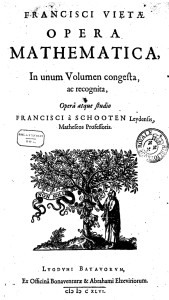
The characteristic polynomial \( {\chi} \) of a sequence of complex numbers \( {z_1,\ldots,z_n} \) is defined by
\[ \chi(z):=\prod_{k=1}^n(z-z_k). \]
If \( {z_1,\ldots,z_n} \) are now random, then one may ask about the roots \( {z_1',\ldots,z_n'} \) of the average characteristic polynomial
\[ \overline{\chi}(z):=\mathbb{E}(\chi(z))=\mathbb{E}\left(\prod_{k=1}^n(z-z_k)\right) =\prod_{k=1}^n(z-z_k'). \]
Note that \( {z_1',\ldots,z_n'} \) are not necessarily real or distinct even if \( {z_1,\ldots,z_n} \) are real and distinct. By expanding we get
\[ \overline{\chi}(z)= z^n+\sum_{k=1}^n\frac{(-1)^k}{k!}z^{n-k} \sum_{i_1\neq\cdots\neq i_k}\mathbb{E}(z_{i_1}\cdots z_{i_k}). \]
(Vieta's formulas: the coefficient of a polynomial are elementary symmetric functions of the roots, in honor of François Viète (1540-1603)). Now, if \( {z_1,\ldots,z_n} \) are independent with common mean \( {m} \) then
\[ \overline{\chi}(z) = z^n+\sum_{k=1}^n\frac{(-1)^k}{k!}z^{n-k} \frac{n!}{(n-k)!}m^k =(z-m)^n. \]
In this case \( {z_1'=\cdots=z_n'=m} \), and
\[ \frac{1}{n}\sum_{k=1}^n\delta_{z_k'}=\delta_m. \]
In contrast, note that by the law of large numbers,
\[ \frac{1}{n}\sum_{k=1}^n\delta_{z_k} \underset{n\rightarrow\infty}{\overset{a.s.}{\longrightarrow}}\mu \]
where \( {\mu} \) is the common law of the \( {z_k'} \). How about the case where \( {z_1,\ldots,z_n} \) are dependent? Let us consider for instance the case where \( {z_1,\ldots,z_n} \) are from the Gaussian Unitary Ensemble i.e. the eigenvalues of a \( {n\times n} \) Gaussian Hermitian random matrix with density proportional to \( {H\mapsto\exp(-n\mathrm{Tr}(H^2))} \). In this case, it is well known that \( {\frac{1}{n}\sum_{k=1}^n\delta_{z_k}} \) tend to the Wigner semi-circle law as \( {n\rightarrow\infty} \). On the other hand, it is well known that \( {\overline{\chi}(z)} \) is the \( {n} \)-th monic Hermite polynomial, and that \( {\frac{1}{n}\sum_{k=1}^n\delta_{z_k'}} \) also tends to the semi-circle law as \( {n\rightarrow\infty} \). Beyond the GUE, there are very nice answers when \( {z_1,\ldots,z_n} \) follow a determinental point process, explored by Adrien Hardy in arXiv:1211.6564. One may ask the same for permanental point processes.
